Bodies and the heavens, nearing and retreating: The planetary world of Leiko Ikemura
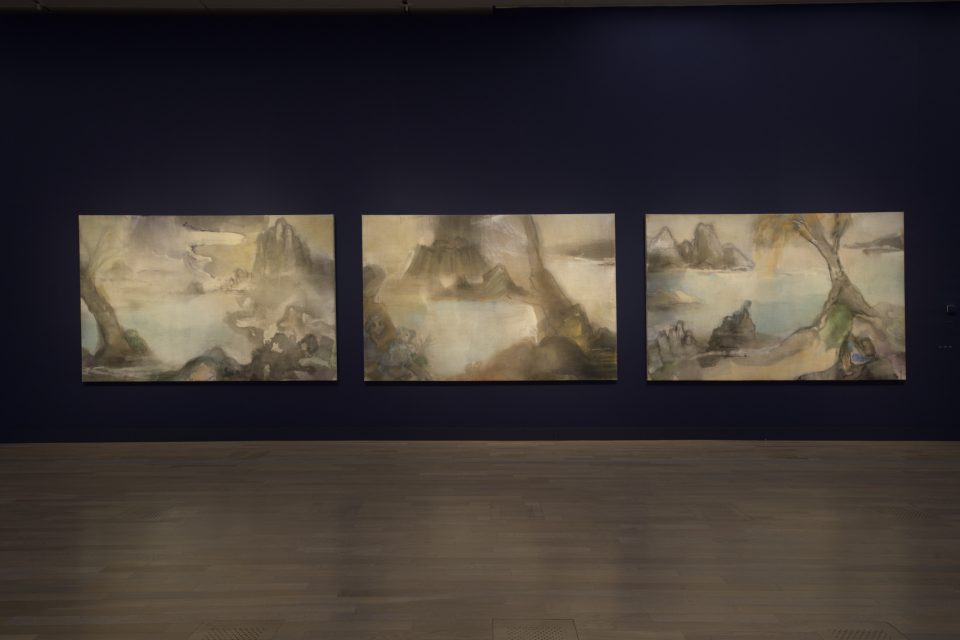 Installation view of the “Cosmicscape” section of “Leiko Ikemura: Our Planet – Earth & Stars” at The National Art Center, Tokyo, 2019. All photos Shigeo Muto, courtesy the artist and ShugoArts.
Installation view of the “Cosmicscape” section of “Leiko Ikemura: Our Planet – Earth & Stars” at The National Art Center, Tokyo, 2019. All photos Shigeo Muto, courtesy the artist and ShugoArts.
When you step into the world created by Leiko Ikemura, you are filled with an indefinable feeling of anxiety. One could almost call it threatening. You cannot look at the objects with an easy mind. And you cannot find anywhere to ground your feelings. Which is why you move on to the next piece without feeling you have finished viewing the piece before properly. And so you end up going back to look at it again. But this doesn’t mean you have left something unseen, so you end up repeating the same process. Perhaps rather than threatening, viewed by bystanders it may seem suspicious. Repeating this activity yet still moving forward, albeit a little at a time. It is a pattern of movement unrelated to the prescribed route, but in time you finally exit the venue. Though you then want to see it again from the beginning. And you realize that you regret the fact that you cannot reenter. Even if you did go in again, however, it is unlikely you would be able to remember why you felt disappointed.
That this is the only way of viewing Ikemura’s work is probably because whatever it is her creations give rise to in viewers’ hearts resemble images but are not. If they were images, the moment one realized what these images were about, somehow or other one’s feelings would settle. But while they may resemble concrete things, in fact Ikemura’s creations do not resemble these things at all. Perhaps it would be more accurate to say that they temporarily house themselves in images of some kind in order to escape.
But just what are these image-like things trying to escape from? If we knew that, then there wouldn’t be any difficulty to begin with. But this doesn’t become clear even at the end. About the only thing that is clear is that the image-like things that manifest in Ikemura’s world are in the midst of a maelstrom of activity as they continually try to escape. To put it another way, when, because they are too exhausted, the viewer resorts to viewing Ikemura’s pictures or sculptures according to such easy-to-understand types as girls or landscapes or figures for the sole reason that they resemble something, one immediately withdraws from the experience that is unique to Ikemura’s artworks. In reality one must reject such solutions and steadfastly remain standing there, but the images being sent moment by moment continue to deviate and change, and eventually one becomes exhausted. The moment one ends up walking away is the moment one’s willingness to endure this suddenly expires. But despite this one’s desire to see the work again doesn’t disappear. Experiences that trigger simultaneously in viewers such feelings of tension and temptation are rare indeed.
This text is a review of “Leiko Ikemura: Our Planet – Earth & Stars,” an exhibition held from January to April of this year at The National Art Center, Tokyo, though in fact until this time I had completely missed the opportunity to view Ikemura’s works collectively. I first learned of this exhibition in an inflight magazine, at which time I was up in the sky. The inside of an airplane is methodically controlled, but for this very reason it is also a restless place. One could also say safety is excessively orchestrated precisely because it is such an extraordinary environment. For a start, clouds spread out below one’s feet with nothing to support the aircraft. And yet that aircraft moves forward in a straight line at a tremendous speed with nothing to stop it. Of course it is best not to concentrate on such things, but learning under these circumstances that such an undertaking involving Ikemura as this exhibition was underway was not a bad thing at least as occasions go. To be frank, I cannot remember much about the contents of the article, but I seem to recall words to the effect that Ikemura was thinking hard about how to provide opportunities to the people who would be coming to see this large-scale exhibition, the first to be held in her home country for some time, alongside a large color photograph of the artist.
In fact this exhibition is put together extremely well and it is very difficult to take it all in. In terms of content it is in effect a large-scale retrospective, yet one barely senses any retrospective elements (which is to say elements looking at the past) at all. The years of production vary, but there is something akin to a rigorousness that does not allow such easy ways of viewing as determining which works are from the past and looking at later works as developments from those. I say “something akin to a rigorousness” as opposed to rigorousness because there is present a certain embracing strength that could almost be called organic that is far from the kind of mechanical regulation we associate with precision. This is something completely different from plain rigorousness, and could even be called inevitably recurring time. Not resisting such recurring forces provides for an experience akin to strictness.
According to the exhibition catalog, it seems Ikemura initially considered structuring the show in the context of recurring time as providence, with spring followed by summer, autumn, winter and then spring again. (1) In the end this was not how it turned out, but recurring time certainly remains as a deep lingering tone, forming the foundation of the exhibition as “a hidden structure.” (2)
There are sixteen sections. First is “Prologue,” followed by “Origin,” “Organic and Inorganic,” “Realm of Drawings,” “Girls,” “Amazon,” “War,” “Usagi Kannon,” “Mountains,” “Garden,” “Trees,” “Flame,” “Horizon,” “Memento Mori,” “Cosmicscape” and finally “Epilogue.” Easy-to-understand words are used in the title of each section, but in fact the works themselves are not all that easy to understand. Rather, it would be better to think of them as mutually permeating each other. But this is not simple cooperation. Things resembling images of living things are constantly clinging to and immediately escaping livings things, and the same applies to girls, fighting, flames, and mothers. The escaping constituent parts go flying in all directions and appear to momentarily occupy other images, but instead of settling there, from the moment they are perceived they extricate themselves (like startled hares?) to adjacent or more distant images.
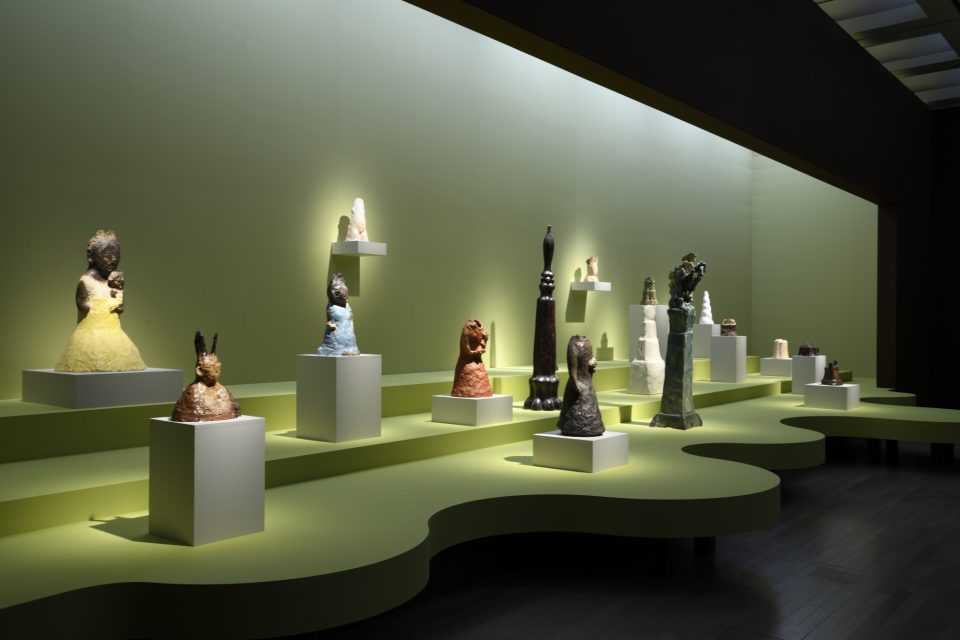 Installation view of “Organic and Inorganic.”
Installation view of “Organic and Inorganic.”
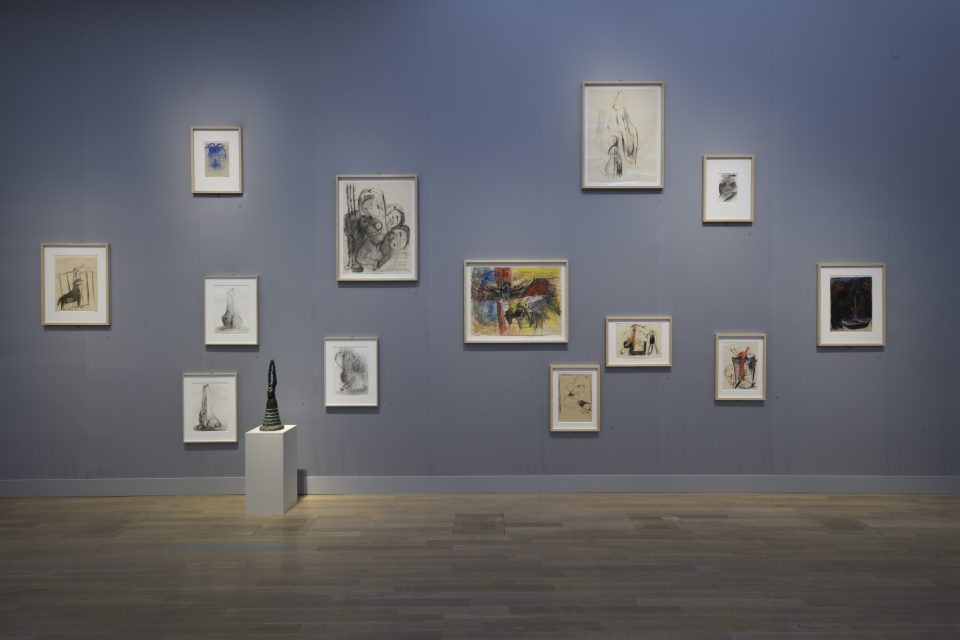 Installation view of the “Realm of Drawings.”
Installation view of the “Realm of Drawings.”
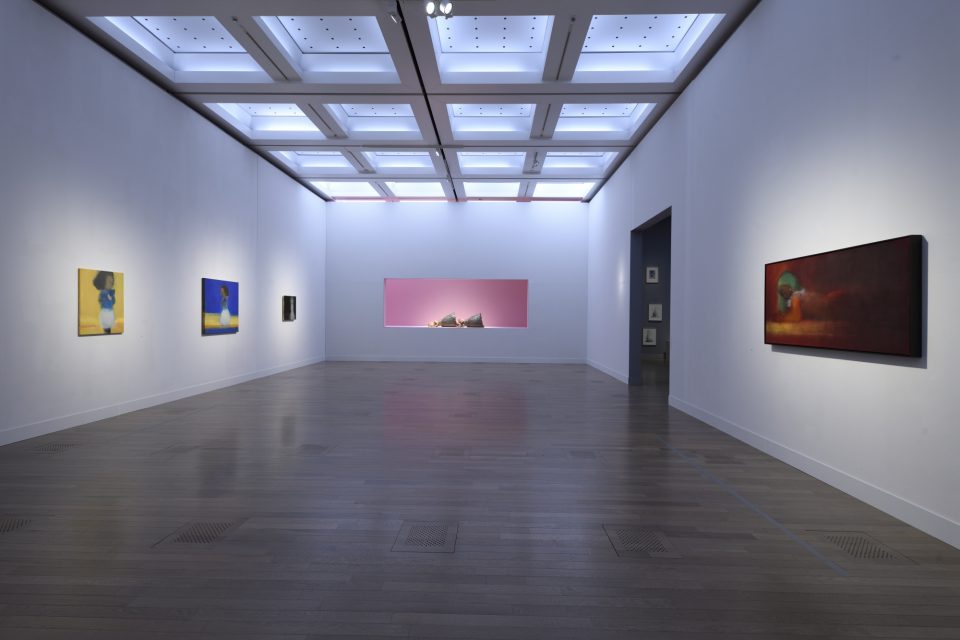 Installation view of “Girls.”
Installation view of “Girls.”
Let us look at the catchiest sounding section, “Girls.” As soon as one tries to view them, the girl-like things begin to metamorphose into things that are not girls. To begin with, the things that one might call girl-like are devoid of clear outlines as pictures, and in many cases one can see the backgrounds through them, almost as if halation has occurred as the artist has sought to quickly capture the subjects immediately prior to their disappearance. This can be seen not only in Ikemura’s paintings, but also in the drawings that characterized the early part of her career. One might think it would be easier to express the nebulous appearance and disappearance of the images in paintings produced using brushes on dampened canvases as opposed to drawings in which the subjects are delineated clearly with lines. But the fact that the lines are clearly drawn does not necessarily mean that our understanding of what the resultant subjects refer to is any clearer. In fact, the lines are only lines, and the parts where pressure has been applied are strong and thick while the parts where it has not are weak and thin, and frankly that is all that results, so that the clearer this difference becomes, the more the indicative effect of the lines as signs recedes. Contrary to paintings, the more clearly the lines are drawn, the more difficult it is to understand what the subjects are. If the “girls” in the paintings are depicted just before they disappear into things that are not girls, then the lines in the drawings have only just appeared and, just as when one has suddenly been brought into a light place from the dark it is too bright for one’s eyes to pick out the subject, the quantity of light (the quantity of lines?) is too great, making it difficult for the viewer to clearly discern what is there.
There is exactly the same with the sculptural works. The forms of Ikemura’s sculptures are not particularly difficult to understand; rather, they have familiar shapes the likes of which anyone can pick out from their memory. However, they have usually been dispossessed of crucial parts, so while they seem familiar, in fact we need to use our imagination to compensate for these missing parts. But because memory material sufficiently clear to do this compensating is nowhere to be found (as long as memory is just memory), the subjects remain suspended in a state somewhere between understanding and non-understanding, and in the meantime we find ourselves suddenly leaning in the direction of not understanding what the subject is.
One could go as far as to say that the way these works by Ikemura are made is slightly different from what we call “making.” Things that are made are quite solid simply due to the fact that they have been made, and it is in fact difficult to see in them the kind of appearance and disappearance in which subjects that exist as things gradually lose their outlines. But one cannot help thinking that Ikemura’s way of making actually seems to be one in which through the act of making she nullifies making and through bringing into existence images she willingly parts with images (this is the only way I can express it). At the venue for this exhibition, a video showing Ikemura in her studio placing paper on her desk and creating a picture was shown, but if anything the manner in which she worked resembled not so much painting with a brush but swiftly erasing a picture with a large eraser. But if one thinks about it, whether one is painting planes or drawing lines, because the creation of a picture can only be advanced by eliminating the possibilities that were otherwise possible, it is somehow pregnant with an abortive quality. To say something is “pregnant” with “abortion” is a strange way of putting it, but it also seems that this contradictory expression captures well the distinguishing features of Ikemura’s pictures and sculptures.
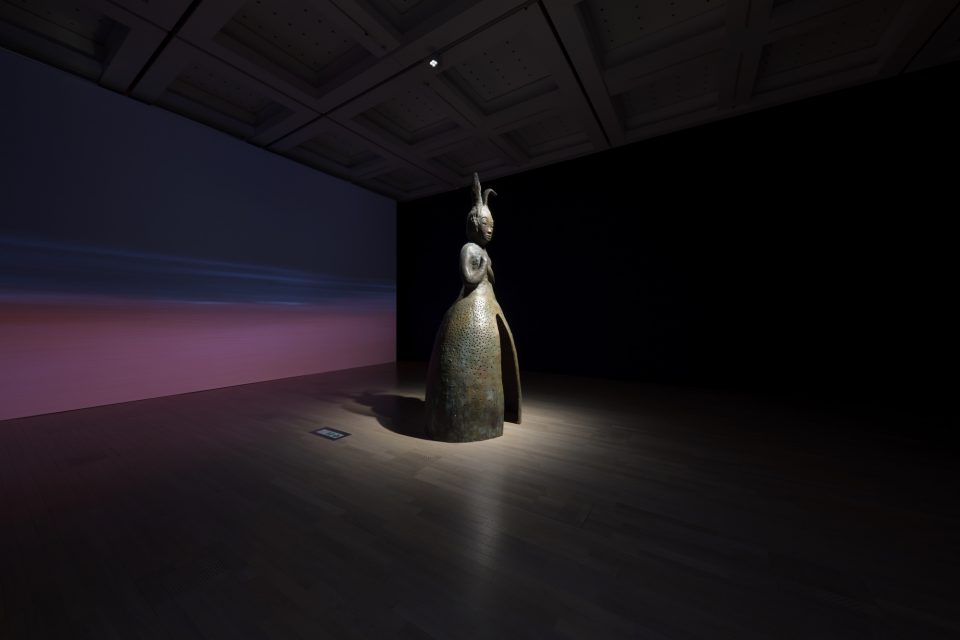 Installation view of “Usagi Kannon.”
Installation view of “Usagi Kannon.”
Another thing that caught my eye at this exhibition was how throughout the discussions included in the catalog it is noted that Ikemura was forced to change her approach to her artworks under the considerable shadow cast by the Tohoku earthquake and tsunami. It was a major event, so this in itself is no surprise. Even Mitsue Nagaya’s reference to this in her essay as a “spiritual crisis” cannot be called an overstatement. In fact, this spiritual crisis is sublimated in the form of Usagi Kannon, which has a cavity in its womb (ie, a void that doesn’t conceive) above all for its own salvation and as a result accepts all things and embraces from the back of its body the things it has accepted. However, the thing I found even more curious was why, after receiving news from so far away of this great disaster in Japan, Ikemura was confronted with a crisis in her art making to such an extent. It seemed to me there was something far more difficult to understand, or perhaps something that was even more intimately connected to Ikemura, than being confronted with and overcoming a crisis.
In the poetic text she provided for the Prologue of this exhibition, Ikemura touches on the inexorable cycle of a raging sea and its calming. This text begins with the words, “This summer, the sea again became calm / as if nothing had happened / but the white sandy beach knows / what the turbulent sea did / and scoops up mementos of separation,” and ends with the words, “where should I go? / I simply lie down on the ground and touch the earth with my body / the passage of time stretches out slowly, endlessly / waves grow high, their surging powerful, ready to produce something again, spring.” Mention these words to anyone and they would probably call to mind the violent giant tsunami that struck the Tohoku region. Moreover, though it is now calm, that sea that caused such loss and sacrifice on land is certainly “ready to produce something again.” This premonition is not something that can be erased even by the clear and mild weather of spring. Or rather, by placing spring – which if we follow the example of spring, summer, autumn and winter is the first of the four seasons – at the end, “their surging” is inscribed as a presentiment of the summer, autumn and winter that are about to be repeated. There is no end to the four seasons, the only reasons we feel they begin with spring being convenience in terms of the calendar, and if they ended with spring, summer would certainly begin after that. Accordingly, didn’t this poem also begin with summer? In this sense, the four seasons are part of a circle that resembles the ouroboros, a serpent swallowing its own tail. A giant tsunami will certainly strike again. Moreover, because in a circle the before and after of time have no meaning, a past giant tsunami is a future giant tsunami, and a future giant tsunami is a past giant tsunami.
I cannot help thinking that this kind of cycle and nullification of time, as well as the vast medium of the sea as something presaging appearance turning into disappearance and disappearance into appearance, closely resemble the movements in Ikemura’s pictures and sculptures, by which I mean the way her images turn into non-images and her non-images begin to look like images. If so, then the argument that Ikemura descended into a spiritual crisis as a result of the Tohoku earthquake and giant tsunami would also be convincing. Weren’t Ikemura’s pictures possessed from the outset with sea-like undulations and changes of the kind that might potentially conceive tsunami?
According to Ikemura she was born and raised in a coastal neighborhood of the city of Tsu in Mie Prefecture. I don’t know exactly what kind of place this was, but if it was a coastal part of Tsu then it may have suffered damage in the giant tsunami triggered by the 1946 Nankai earthquake. Even if it didn’t, Tsu, which faces Ise Bay, has had a deep affinity with storm surges and typhoons since olden times. I don’t know anything about Ikemura’s experience of Typhoon Vera (known in Japan as the Isewan Typhoon) or where she was in 1959 when it struck Ise Bay, but if she was “born and raised in a coastal neighborhood of the city of Tsu in Mie Prefecture,” it would not be surprising if it had left its mark on her as some kind of memory. Could it be that the distant Far Eastern land was not Tohoku, but something even more abstracted in the sense of “Tsu” itself? Doesn’t the aspect of Tsu as a place where the sea ebbed and flowed repeatedly, occasionally producing storm surges that swallowed up people’s livelihoods altogether, unconsciously bear a great deal as a vessel that erases while continually representing the self, not creating but created, devoid of a specific shape or image? Perhaps Ikemura came to such a realization. And perhaps it is for this very reason that she has been increasingly strongly attracted to Far-Eastern-style landscape paintings as “archetypical images.”
The place name “Tsu” itself is disquieting. In ancient times, the word tsu meant “harbor,” and the origins of the present-day city of Tsu can be traced to the Heian period when the port of Anotsu prospered due to the important role it played on the journey to Kyoto. However, Anotsu was destroyed by a giant tsunami triggered by a massive earthquake in 1498, and even today its exact location at the time is not known. Though I haven’t examined the origins of the use of the word “tsunami” in Japan, considering that Anotsu was a leading port in Japan at the time and could be called a byword of sorts for almost all of the tsu (ports) in Japan, the word “tsunami” (made up of the characters for “harbor” and “wave”) may have originally referred to a giant wave on the scale of the one that struck Anotsu and consigned the port of Ano to oblivion. I know this is a somewhat excessive leap in terms of creative logic. But if we consider for the time being that the above is true, then a tsunami is a wave (nami) that strikes a port (tsu), and Ikemura was born and raised in the home of tsu–nami. In other words, hasn’t Ikemura potentially always been making pictures of the sea? And hasn’t she been trying to capture something akin to images being swept away by waves from the moment they are created? To put in another way, isn’t the very spiritual crisis she was confronted with essentially something like a tsunami?
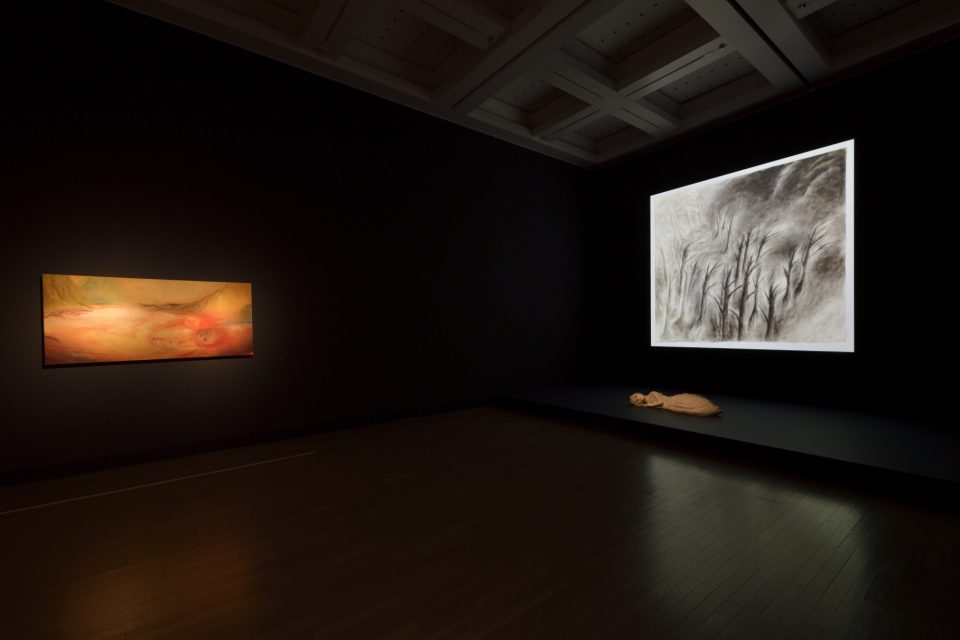 Installation view of “Memento Mori.”
Installation view of “Memento Mori.”
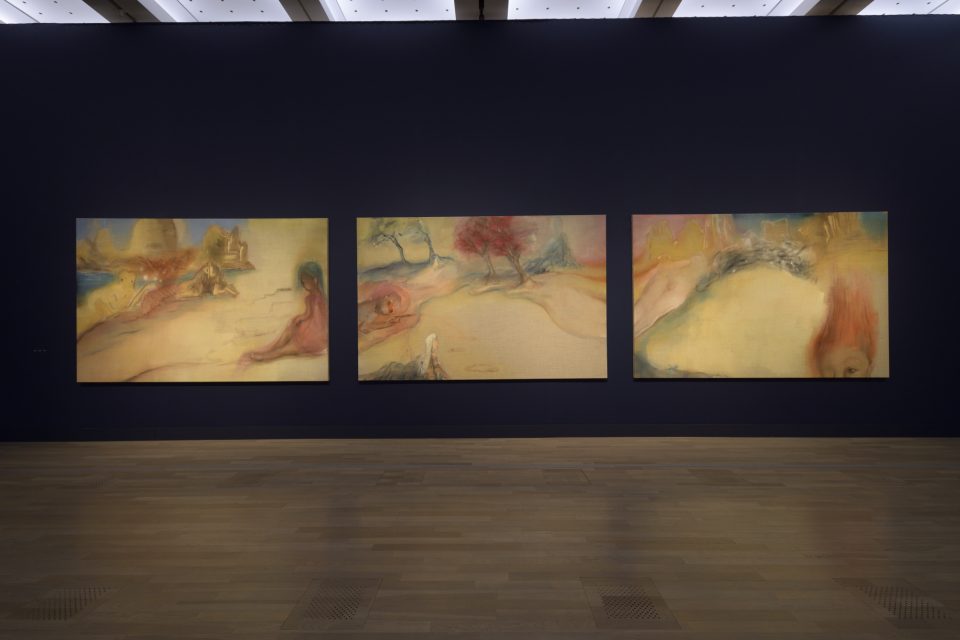 Installation view of “Cosmicscape.”
Installation view of “Cosmicscape.”
If for Ikemura the Tohoku earthquake and tsunami was not something she worried about from a distant country as a crisis in her homeland, but a more fundamental, pressing crisis like the one I have just described, then it was a crisis she had to overcome for the moment with Far-Eastern landscape paintings as “archetypical images” if it was to have any meaning. But these could not be traditional, or what one might call “miniature garden-like,” Far-Eastern-style landscapes. At present, for Ikemura, the planet Earth is a water planet, and the atmosphere is overflowing with water components. Her Far-Eastern-style landscapes needed to have tsunami and torrential rain, landslides and earthquakes, and they needed to incorporate raging seas of a universal dimension. No doubt this is the thing that bears the title “Cosmicscape” and that takes up the largest space at this exhibition. Here, volcanoes stand in a row, billowing smoke is spewed into the air, and creatures lie scattered as bodies with their eyes plucked out. Though despite this, everything does not end with death, as for the survivors spring will come again and they will be greeted with flowers, and for this very reason these works are Far-Eastern-style landscapes as memento mori for the life that remains. And it is none other then our very selves that are the survivors. Which is precisely why the exhibition title is “Our Planet – Earth” (body) and “Stars” (the heavens), for isn’t the Earth, as the literal translation of the Japanese word for planet, yusei, suggests, “a wandering heavenly body”? Unlike the sun, planets roam the heavens. Which is why in Japanese a planet is also called wakusei, literally “a lost heavenly body.” And what better way to describe our own Earth than a “lost” or “wandering” heavenly body? Cosmicscape likens this Earth not to something fixed but to an ever-changing sphere, making it over as Far-Eastern-style landscapes on the dimension of the stars, which is probably the real significance of this exhibition being titled Earth & Stars.
“Leiko Ikemura: Our Planet – Earth & Stars” was held at The National Art Center, Tokyo, from January 18 to April 1, 2019.
1. Mitsue Nagaya, “Leiko Ikemura and the Generation of Images,” in Leiko Ikemura: Our Planet – Earth & Stars (Tokyo: Kyuryudo, 2019), p. 31.
2. Ibid.
On July 6, Noi Sawaragi will participate in a discussion with Naoki Sato and Gabin Ito (editor) held at Art Museum and Library, Ota, in conjunction with the exhibition Books and Arts 3: “Naoki Sato: Paper, Murals, Cycles.”</a
